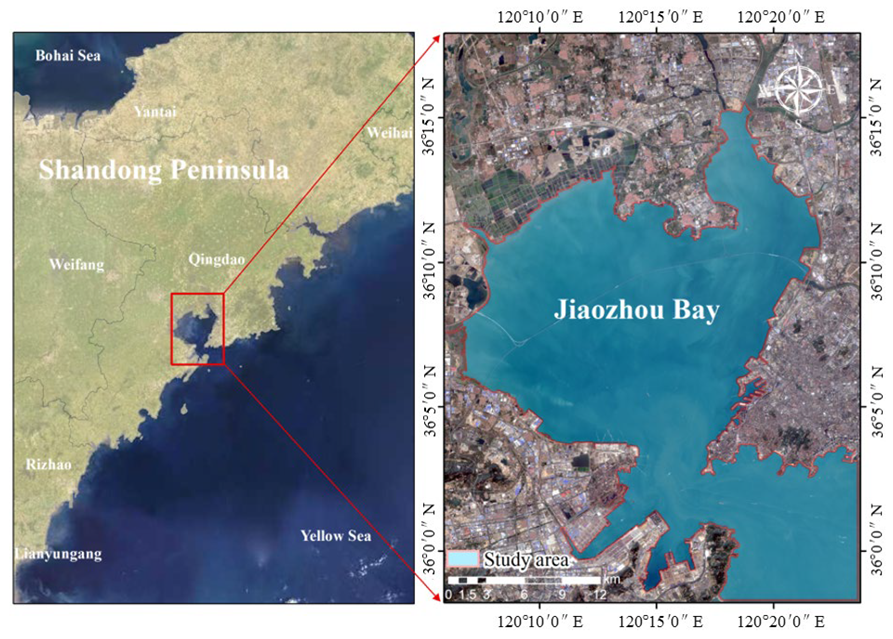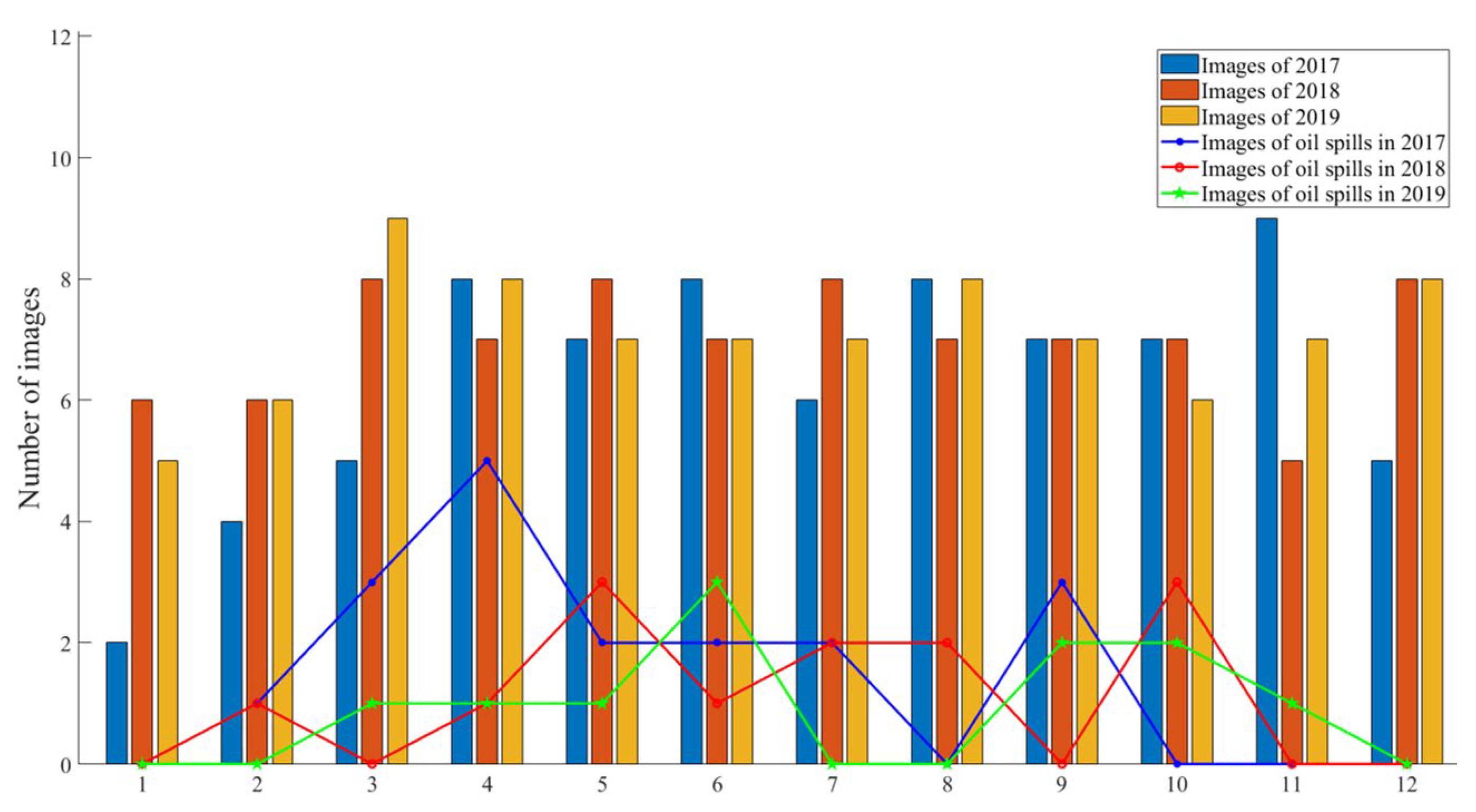Monitoring of Oil Spill Risk in Coastal Areas Based on Polarimetric SAR Satellite Images and Deep Learning Theory
Abstract
:1. Introduction
2. Study Area and Data Sources
2.1. Study Area
2.2. Data Sources
3. Method
3.1. The Baic Architecture
3.2. Multi-Feature Input
4. Experimental Results
4.1. Quantitative Assessment Indices
4.2. Assessment of Oil Spill Identification Accuracy
4.3. Monitoring of Oil Spill Risk in Jiaozhou Bay
5. Discussion
5.1. Data Limitation
5.2. Comparison with Related Works
6. Conclusions
Author Contributions
Funding
Institutional Review Board Statement
Informed Consent Statement
Data Availability Statement
Conflicts of Interest
References
- Deyoung, B.; Visbeck, M.; Filho, M.; Baringer, M.O.; Willis, Z. An integrated all-Atlantic ocean observing system in 2030. Front. Mar. Sci. 2019, 6, 428. [Google Scholar] [CrossRef]
- Chen, J.H.; Zhang, W.P.; Li, S.F.; Zhang, F.W.; Zhu, Y.H.; Huang, X.L. Identifying critical factors of oil spill in the tanker shipping industry worldwide. J. Clean. Prod. 2018, 180, 1–10. [Google Scholar] [CrossRef]
- Zhang, W.P.; Li, C.X.; Chen, J.H.; Wan, Z.; Shu, Y.Q.; Song, L.; Di, Z.J. Governance of global vessel-source marine oil spills: Characteristics and refreshed strategies. Ocean Coast. Manag. 2021, 213, 105874. [Google Scholar] [CrossRef]
- Simecek-Beatty, D.; Lehr, W.J. Extended oil spill spreading with Langmuir circulation. Mar. Pollut. Bull. 2017, 122, 226–235. [Google Scholar] [CrossRef]
- Davidson, W.F.; Lee, K.; Cogswell, A. Oil Spill Response; Springer: Berlin/Heidelberg, Germany, 2008; Volume 3, pp. 241–246. [Google Scholar]
- An, H.; Zhong, W.; Chen, Y.; Li, H.; Gao, X. Features and evolution of international crude oil trade relationships: A trading-based network analysis. Energy 2014, 74, 254–259. [Google Scholar] [CrossRef]
- ITOPF. The International Tanker Owners Pollution Federation Limited Oil Tanker Spill Statistics; ITOPF: London, UK, 2020. [Google Scholar]
- Yin, L.; Zhang, M.; Zhang, Y.; Qiao, F. The long-term prediction of the oil-contaminated water from the Sanchi collision in the east China sea. Acta Oceanol. Sin. 2018, 37, 34. [Google Scholar] [CrossRef]
- Xue, X.S.; Song, L.; Fu, Z.L. Ecological risk assessment of red tide in Qinhuangdao coastal waters. Fish. Sci. 2019, 38, 695–701. [Google Scholar]
- Bing, L.; Xing, Q.G.; Liu, X.; Zou, N.N. Spatial distribution characteristics of oil spills in the Bohai sea based on satellite remote sensing and GIS. J. Coast. Res. 2019, 90, 164–170. [Google Scholar] [CrossRef]
- Stroming, S.; Robertson, M.; Mabee, B.; Kuwayama, Y.; Schaeffer, B. Quantifying the human health benefits of using satellite information to detect cyanobacterial harmful algal blooms and manage recreational advisories in US lakes. Geohealth 2020, 4, e2020GH000254. [Google Scholar] [CrossRef]
- Hedayati, A.; Pirali Zefrehei, A.R.; Sahraei, H. Ecological environment monitoring for sustainable development goals in Gomishan international wetland, Gorgan Bay, Caspian Sea. Environ. Sci. Pollut. Res. 2023, 30, 50134–50143. [Google Scholar] [CrossRef]
- Ma, X.S.; Xu, J.G.; Pan, J.; Yang, J.; Wu, P.H.; Meng, X.C. Detection of marine oil spills from radar satellite images for the coastal risk assessment. J. Environ. Manag. 2023, 325, 116637. [Google Scholar] [CrossRef] [PubMed]
- Fan, Y.; Rui, X.; Zhang, G.; Poslad, S. Feature merged network for oil spill detection using SAR images. Remote Sens. 2021, 13, 3174. [Google Scholar] [CrossRef]
- Shaban, M.; Salim, R.; Khalifeh, H.A.; Khelifi, A.; Shalaby, A.; El-Mashad, S.; Mahmoud, A.; Ghazal, M.; EI-Baz, A. A deep-learning framework for the detection of oil spills from SAR data. Sensors 2021, 21, 2351. [Google Scholar] [CrossRef] [PubMed]
- Ma, X.S.; Xu, J.G.; Wu, P.H.; Kong, P. Oil Spill Detection Based on Deep Convolutional Neural Networks Using Polarimetric Scattering Information from Sentinel-1 SAR Images. IEEE Trans. Geosci. Remote Sens. 2022, 60, 4204713. [Google Scholar] [CrossRef]
- Shi, L.J.; Zhao, C.F.; Liu, P. Oil spill identification method based on texture analysis and artificial neural network in SAR images. J. Ocean Univ. China 2009, 7, 1269–1274. [Google Scholar]
- Skrunes, S.; Brekke, C.; Eltoft, T. An experimental study on oil spill characterization by multi-polarization SAR. In Proceedings of the EUSAR 2012; 9th European Conference on Synthetic Aperture Radar, Nuremberg, Germany, 23–26 April 2012; pp. 139–142. [Google Scholar]
- Dong, Y.Z.; Liu, Y.X.; Hu, C.M.; MacDonald, I.R.; Lu, Y.C. Chronic oiling in global oceans. Science 2022, 376, 1300. [Google Scholar] [CrossRef]
- Krestenitis, M.; Orfanidis, G.; Ioannidis, K.; Avgerinakis, K.; Kompatsiaris, I. Oil spill identification from satellite images using deep neural networks. Remote Sens. 2019, 11, 1762. [Google Scholar] [CrossRef]
- Chen, G.; Li, Y.; Sun, G.; Zhang, Y. Application of deep networks to oil spill detection using polarimetric synthetic aperture radar images. Appl. Sci. 2017, 7, 968. [Google Scholar] [CrossRef]
- Ling, Z.; Lxa, C.; Jla, C.; Xhab, C. Long-term changes of nutrients and biocenoses indicating the anthropogenic influences on ecosystem in Jiaozhou Bay and Daya Bay, China. Mar. Pollut. Bull. 2021, 168, 112406. [Google Scholar]
- Zhang, S. Tidal flat extraction and change analysis based on the rf-w model: A case study of Jiaozhou Bay, east China. Remote Sens. 2021, 13, 1436. [Google Scholar]
- Liang, X.; Zhen, Z.; Song, Y.; Jian, L.; Songa, D. Pol-SAR based oil spillage classification with various scenarios of prior knowledge. IEEE Access 2019, 7, 66895–66909. [Google Scholar] [CrossRef]
- Dasari, K.; Anjaneyulu, L.; Nadimikeri, J. Application of C-band Sentinel-1A SAR data as proxies for detecting oil spills of Chennai, east coast of India. Mar. Pollut. Bull. 2021, 174, 113182. [Google Scholar] [CrossRef]
- Huang, X.; Zhang, B.; Perrie, W.; Lu, Y.; Wang, C. A novel deep learning method for marine oil spill detection from satellite synthetic aperture radar imagery. Mar. Pollut. Bull. 2022, 179, 113666. [Google Scholar] [CrossRef] [PubMed]
- Lu, Z.; Ma, W.; Dan, Z. Stacked sparse autoencoder in PolSAR data classification using local spatial information. IEEE Geosci. Remote Sens. Lett. 2017, 13, 1359–1363. [Google Scholar]
- Ma, X.; Huang, Z.; Zhu, S.; Fang, W.; Wu, Y. Rice Planting Area Identification Based on Multi-Temporal Sentinel-1 SAR Images and an Attention U-Net Model. Remote Sens. 2022, 14, 4573. [Google Scholar] [CrossRef]
- Lee, J.S.; Pottier, E. Polarimetric Radar Imaging: From Basics to Applications; Chemical Rubber Company Press: Boca Raton, FL, USA, 2009. [Google Scholar]
- Ma, X.S.; Wang, C.; Yin, Z.X.; Wu, P.H. SAR Image Despeckling by Noisy Reference-Based Deep Learning Method. IEEE Trans. Geosci. Remote Sens. 2020, 58, 8807–8818. [Google Scholar] [CrossRef]
- Roberto, N.; Baldini, L.; Facheris, L.; Chandrasekar, V. Modeling COSMO-SkyMed measurements of precipitating clouds over the sea using simultaneous weather radar observations. Atmos. Res. 2014, 144, 138–156. [Google Scholar] [CrossRef]
- Colin, A.; Peureux, C.; Husson, R.; Fablet, R.; Tandeo, P. Segmentation of rainfall regimes by machine learning on a colocalized Nexrad/Sentinel-1 dataset. In Proceedings of the IEEE International Geoscience and Remote Sensing Symposium, Kuala Lumpur, Malaysia, 17–22 July 2022; pp. 307–309. [Google Scholar]
- Hersbach, H.; Stoffelen, A.; Haan, S.D. An improved C-band scatterometer ocean geophysical model function: CMOD5. J. Geophys. Res. Ocean. 2007, 112, C03006. [Google Scholar] [CrossRef]
- Chen, L.C.; Papandreou, G.; Kokkinos, I.; Murphy, K.; Yuille, A.L. DeepLab: Semantic image segmentation with deep convolutional nets, atrous convolution, and fully connected CRFs. IEEE Trans. Pattern Anal. Mach. Intell. 2018, 40, 834–848. [Google Scholar] [CrossRef]
- Chen, L.C.; Papandreou, G.; Schroff, F.; Adam, H. Rethinking atrous convolution for semantic image segmentation. arXiv 2017, arXiv:1706.05587. [Google Scholar]
- Cloude, S.R.; Pottier, E. An entropy based classification scheme for land applications of polarimetric SAR. IEEE Trans. Geo. Remote Sens. 1997, 35, 551935. [Google Scholar] [CrossRef]
- Grecu, M.; Olson, W.S.; Munchak, S.J.; Ringerud, S.; Liao, L.; Haddad, Z.; Kellely, B.L.; McLaughlin, S.F. The GPM Combined Algorithm. J. Atmos. Ocean. Technol. 2017, 33, 2225–2245. [Google Scholar] [CrossRef]
- Conradsen, K.; Nielsen, A.; Schou, J. A test statistic in the complex Wishart distribution and its application to change detection in polarimetric SAR data. IEEE Trans. Geosci. Remote Sens. 2002, 41, 4–19. [Google Scholar] [CrossRef]
- Huang, J.; Guo, L.J.; Jiang, T.; Zhu, H.C. Three Decades of Sea-Ice Variability in Jiaozhou Bay Revealed by Landsat Observations. J. Ocean Univ. China 2019, 18, 349–357. [Google Scholar] [CrossRef]
- Liu, Z.; Chen, Q.; Zhang, Y.W.; Zheng, C.; Cai, B.P.; Liu, Y.H. Research on transport and weathering of oil spills in Jiaozhou Bight, China. Reg. Stud. Mar. Sci. 2022, 51, 102197. [Google Scholar] [CrossRef]









| Method | OA | MIoU |
|---|---|---|
| PolSAR Wishart | 0.8215 | 0.7238 |
| The proposed model using feature set δ1 | 0.9664 | 0.9180 |
| The proposed model using feature set δ2 | 0.9818 | 0.9559 |
| The proposed model using feature set δ3 | 0.9838 | 0.9606 |
Disclaimer/Publisher’s Note: The statements, opinions and data contained in all publications are solely those of the individual author(s) and contributor(s) and not of MDPI and/or the editor(s). MDPI and/or the editor(s) disclaim responsibility for any injury to people or property resulting from any ideas, methods, instructions or products referred to in the content. |
© 2023 by the authors. Licensee MDPI, Basel, Switzerland. This article is an open access article distributed under the terms and conditions of the Creative Commons Attribution (CC BY) license (https://creativecommons.org/licenses/by/4.0/).
Share and Cite
Liao, L.; Zhao, Q.; Song, W. Monitoring of Oil Spill Risk in Coastal Areas Based on Polarimetric SAR Satellite Images and Deep Learning Theory. Sustainability 2023, 15, 14504. https://doi.org/10.3390/su151914504
Liao L, Zhao Q, Song W. Monitoring of Oil Spill Risk in Coastal Areas Based on Polarimetric SAR Satellite Images and Deep Learning Theory. Sustainability. 2023; 15(19):14504. https://doi.org/10.3390/su151914504
Chicago/Turabian StyleLiao, Lu, Qing Zhao, and Wenyue Song. 2023. "Monitoring of Oil Spill Risk in Coastal Areas Based on Polarimetric SAR Satellite Images and Deep Learning Theory" Sustainability 15, no. 19: 14504. https://doi.org/10.3390/su151914504




